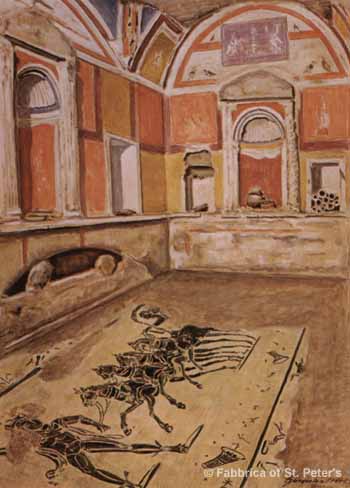
|
Tomb
of the Chariot (Tomb I)
Tomb
I, of the Quadriga - or Chariot - takes its name from
the main figure of the mosaic pavement. White and
black marble pieces depict the rape of Persephone
by Pluto on a chariot driven by Mercury.
The
border surrounding the mosaic depicts a series of
animals, tigers and gazelles, among vases and flowering
plants.
The
frescoes present country scenes in which the viewer
should notice a peacock, a duck, doves, and other
birds, together with floral designs.
From:
'Guide to the Vatican Necropolis' by Michele Basso,
Fabbrica di S. Pietro
|
Located
between the two eastern pillars of the dome parallel to
the altar of St Peter in the central nave of the Vatican
Grottoes, this building was invaded by the foundations of
both the old and the new basilica. It was therefore one
of the last mausoleums of the necropolis to be explored
and only in 1946 was it possible to open the passage near
the southeastern corner that now grants access to the sepulchre.
A wall of tufa blocks and bricks replaced the original facade;
it was built in the 4th century and used the door jambs
of the travertine portal on which the legal measurements
of the building were sculpted in indexed characters: twelve
feet wide and fifteen deep (the side wall are three feet
longer).
Sources
P. Zander. The Vatican Necropolis, in "Roma
Sacra", 25, Roma 2003
Margherita Guarducci,
The Tomb of St Peter, Hawthorn Books, 1960
John Evangelist Walsh,
The Bones of St Peter, New York, 1982
J. Toynbee - J.W. Perkins. The Shrine of St Peter and
the Vatican Excavations, London 1956
Michele
Basso. Guide to the Vatican Necropolis, Fabbrica
di S. Pietro in Vaticano, 1986
P. Zander. Creating St Peter's. Knights of Columbus
Museum, 2004